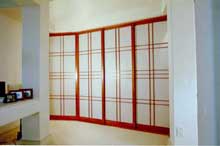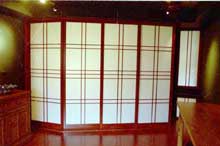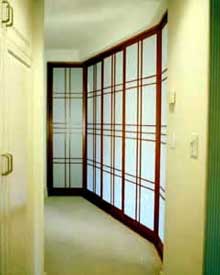|
Shoji Screens
During the Heian period (800 A.D.) to the early Edo period (1876 A.D.). Samurai practiced woodworking in their spare time. Bush Art Craft, the Americanized version of the name "Bushi Kogi" (lit. Samurai Art Craft) originated in Seattle, Washington, 1954. In the 1960's the name was changed to Bush Woodcraft to clarify our focus on woodworking. Bush Woodcraft has been making custom made shoji screens for over 45 years. Although we still use many of the traditional techniques brought over from Japan, we have made subtle modifications to our shoji to improve their function and bring them into the 21st century. Shoji screens are an elegant way to add privacy to any room.That makes them a very effective room divider and light diffuser. They are also used today as a very simple and yet artfully delightful way to cover up closets and other working spaces as well as window and patio door coverings.
We can make a custom shoji for you using a number of different wood & paper combinations.
Wood Types
| Our standard shoji are made of basswood. Basswood is a fine grained, light colored wood. It is very suitable for shoji construction. Yellow Cedar has a similar grain and is a light color. It was a type of wood that was often used to make shoji many years ago. |
|
back to top
Insert Material
|
We use a synthetic white rice paper made of fiberglass that is very natural looking and is very beautiful when the light diffuses through it. This material is far more practical than real rice paper and is very durable and washable. We will use customer supplied special papers of your choice upon request. In the past these papers have been laminated to the outside of a thin plastic sheet to add strength and durability to these papers. In addition to paper, there are many different types of decorative plastics and glass that can be substituted. Please call us if you have a special insert material in mind that you are not quite sure of.
|
back to top
Track Systems
|
Wood Track:
We make a top and bottom wood track for exclusive use with our doors. This track system has been slightly modified from the traditional Japanese tracks for smoother sliding action and easier cleaning.
Metal track:
Upon request we can make our doors compatible with a high quality metal track to eliminate the need for a bottom track. If you wish to have more than two doors on a metal track with no bottom track, we offer our special "slide-align" hardware to link the doors together
Other:
Just about any application that can be done with a regular door can be done with shoji. Bifold, Multifold, hinged and freestanding are some other typical applications that have been done for customers.
|
|
back to top
Templates
|
Click here to see some popular grid designs that have been made in the past. Perhaps you will like one of these patterns or they will help to inspire your own design. Remember, the spacial relationship of the pattern will change in relation to the height and width of the frame it is in. We can consult with you to help create the look you want.
|
|

1.7 Horizontal
|

2.9 Horizontal
Rectangle
|

3.7 Square
Pattern
|

4.4 Vertical
Rectangle
|

Bainbridge
|

Hana
|

Kabuki
|

Queen Anne
|
[ click any image to zoom in ]
|
|
back to top
Measuring
|
Measure the overall height and width of the opening you wish to install your shoji in. Then determine the number of panels you want in the opening. Because there are many variables depending on the type of application i.e.: wood track, metal track, bi-fold, etc., give us a call and we will be happy to help you determine the final dimensions of your shoji. With your approximate measurements and the number of panels, we can also develop a cost for your screens. Many of our customers will take delivery of their track system first, install it, and then call us with the finished height and width measurements before we start the final assembly on their shoji order. This helps to eliminate many errors and allows for more flexibility when remodeling to deal most effectively with any unforeseen situations.Remember, as with any door installation, plumb and square are the primary keys to a successful job. Please feel free to call us with any questions you may have on measuring and/or installation.
|
|
back to top
|













